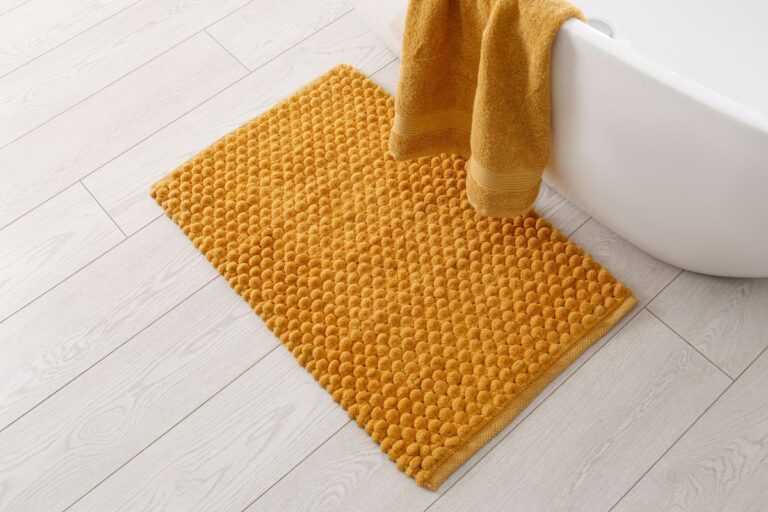Bath mats are more than just a cozy accessory for your bathroom. They also help you prevent slips and falls, and protect your floor from water damage. But do you know how to properly wash and care for your bath mats? If not, we’ve got you covered.
In this blog post, we’ll show you the best ways to clean your bath mats, how to remove stains and odors, and how to extend their life.
Let’s dive in!
How Often Do You Need to Wash Your Bath Mats?
Bath mats are exposed to a lot of moisture, dirt, and bacteria every day. They can harbor mold, mildew, and germs that can cause unpleasant smells and health problems. That’s why it’s important to wash your bath mats regularly to keep them fresh and sanitary.
How frequent you should be washing your bath mats depends on:
- How often you use your bathroom.
- How many people share the bathroom.
- The type of material your bath mat is made of.
As a general rule, you should wash your bath mats at least once a week.
Wash them more often if they get visibly dirty or smelly.
You should also wash your bath mats after someone in your household has been sick, or if you have pets that wander into the bathroom.
The Best Ways to Wash Your Bath Mats
Before you start washing your bath mats, having the following equipment and materials ready can make it easy:
Appliances/ Tools
- A washing machine or a bathtub
- A clothesline or a drying rack
- A vacuum cleaner or a broom (optional)
Cleaning Supplies
- A mild laundry detergent
- A stain remover
- A disinfectant (optional)
- A fabric softener (optional)
- A vinegar and/or baking soda (optional)
How to Wash Your Bath Mats in the Washing Machine
As long as your bath mat is machine-washable, washing it in the washing machine is the easiest and most convenient method.
To know for sure, check its care label to see if its washing-machine friendly, and what settings and temperature to use.
These are the steps to wash your bath mat properly:
Shake Out the Dirt and Hair
Before putting your bath mat in the washing machine, shake it out over a trash can or outside to remove any loose hair, dust, dirt, and debris. You can also use a vacuum cleaner or a broom to sweep away dust or lint.
Follow the Care Label Instructions
Read the care label on your bath mat carefully and follow the manufacturer’s instructions.
Some bath mats may require a gentle or delicate cycle, a low or medium temperature, or a specific type of detergent. Be careful with bleach, as it can damage the fibers and the color of your bath mat.
Add Detergent and Other Additives
Place your bath mat in the washing machine, along with a mild laundry detergent.
You can also add a disinfectant, such as vinegar or bleach, to kill any germs and eliminate any odors. However, never mix bleach and vinegar, as they can create toxic fumes.
If you want to add some softness and fragrance to your bath mat, you can also use a fabric softener. But use it sparingly, as it can reduce the absorbency of your bath mat. Adding a 1/2 cup of vinegar to your wash cycle is more clean and friendly softening solution.
It’s Best to Wash Your Bath Mat Separately or with Similar Items
Avoid washing your bath mat with clothing, as it may transfer lint and color. And it can be a pain to remove afterwards.
And don’t overload the washing machine, as it can cause your bath mat to lose its shape and texture. And wash your bath mat with similar items, such as towels or rugs.
Air Dry Your Bath Mat
After the washing cycle is done, take out your bath mat and shake it gently to fluff up the fibers. Do not wring or twist your bath mat, as it can damage the material and the backing.
Then hang your bath mat on a clothesline or a drying rack, and let it air dry completely.
Do not use a dryer, as it can shrink, melt, or warp bath mats that have synthetic backing. If you have to use a dryer, use a low heat setting and a gentle cycle, and check on it frequently.
How to Hand-Wash Your Bath Mat
If your bath mat is not machine-washable, or if you prefer to wash it by hand, you can use your bathtub or a large sink to clean it.
Here are the steps to hand-wash your bath mat:
Shake Off the Excess Dirt and Debris
As with the machine-washing method, shake out your bath mat before you wash it to get rid of any loose dirt or hair.
Fill Your Tub or Kitchen Sink with Water and Detergent
Fill your bathtub or sink with warm water and add a few drops of mild laundry detergent. You can also add a disinfectant, such as vinegar or bleach, to sanitize your bath mat and remove any odors.
Again, never mix bleach and vinegar, as they can create harmful fumes. And only use bleach if the care tag on the mat says it’s acceptable.
Soak and Scrub Your Bath Mat
Submerge your bath mat in the water and detergent solution, and let it soak for about 30 minutes. Then, use a soft brush or a wet rag to scrub any stains or spots.
Rinse and Dry Your Bath Mat
Drain the water from the tub or sink, and rinse your bath mat with cold water until the water runs clear. Squeeze out the excess water from your bath mat, but do not wring or twist it.
Hang your bath mat on a clothesline or a drying rack, and let it air dry completely. Don;t use a dryer unless it’s 100% cotton, as it can damage your bath mat.
How to Clean a Rubber Backed or Plastic Bath Mat
Some bath mats have a plastic or rubber backing to prevent them from slipping on the floor. These bath mats require special care, as the backing can peel off or crack if washed or dried incorrectly.
Here are some tips to wash a plastic or rubber-backed bath mat:
- Do not wash your plastic or rubber-backed bath mat in the washing machine, as the agitation can cause the backing to come off or deteriorate. Hand-wash your bath mat instead, by following the steps above.
- Do not use bleach, as it can cause the backing to break down. Use a mild detergent and a disinfectant, such as vinegar, instead.
- Air dry your bath mat on a flat surface, away from direct sunlight or heat sources. Don’t use a dryer. Heat can melt or warp the backing.
- Make sure the backing is completely dry before you use your bath mat again.
How to Remove Stains and Odors from Your Bath Mats
Bath mats can get stained or smelly over time, especially if they are not washed regularly.
Here are some ways to treat common stains and odors on your bath mats:
- For Urine Stains and Odors: use a vinegar or baking soda solution to neutralize the smell and lift the stain. Mix one part vinegar or baking soda with two parts water, and spray or pour the solution on the affected area. Let it sit for 10 minutes, then blot with a clean cloth. Repeat as needed until the stain and odor are gone.
- For Blood Stains: use cold water and a stain remover to break down the stain. Do not use hot water, as it can set the stain. Apply the stain remover to the stain, and gently rub it with your fingers or a soft brush. Rinse with cold water, and repeat until the stain is gone. Hydrogen peroxide works well on white natural fibers.
- For Makeup Stains: Use rubbing alcohol or a makeup remover to dissolve. Apply the alcohol or makeup remover to a cotton ball or a cloth, and dab it on the stain. Rinse with water, and repeat until the stain is gone.
- For Mold and Mildew Stains and Odors: Use bleach or vinegar to kill the fungus and remove the stain. Mix one part bleach or vinegar with four parts water, and spray or pour the solution on the affected area. Let it sit for 15 minutes, then scrub with a soft brush. Rinse with water, and repeat until the stain and odor are gone.
How to Keep Your Bath Mats Looking Their Best
To extend the life of your bath mats and keep them in good condition, follow these tips:
- Shake out your bath mats after each use to remove any excess water and hair.
- Hang your bath mats to dry after each use, and avoid leaving them on the floor or in a damp place.
- Vacuum or sweep your bath mats regularly to remove any dust or lint.
- Rotate your bath mats every week to keep them sanitized and prevent wear and tear.
- Replace your bath mats when they become worn out, faded, or torn.
Bath Mat Care and Maintenance Guide
| Cleaning Method | Frequency | Equipment / Tools | Materials | Special Instructions |
|---|---|---|---|---|
| Machine Washing | At least once a week | Washing machine or bathtub, Clothesline or drying rack, Vacuum cleaner or broom | Mild laundry detergent, Stain remover, Disinfectant (optional), Fabric softener (use sparingly), Vinegar or baking soda solution (optional) | Follow care label instructions, Air dry; do not use a dryer, Do not overload the machine; wash separately or with similar items |
| Hand Washing | At least once a week | Bathtub or large sink, Clothesline or drying rack, Vacuum cleaner or broom | Mild laundry detergent, Stain remover, Disinfectant (optional), Fabric softener (use sparingly), Vinegar or baking soda solution (optional) | Air dry; do not use a dryer, Avoid wringing or twisting the mat |
| Special Care for Plastic- or Rubber-Backed Bath Mats | As needed | Hand washing, Vacuum cleaner or broom | Mild detergent, Disinfectant (optional) | Lay flat to air dry; avoid using a dryer |
We hope this blog post has helped you learn how to wash and care for your bath mats. By following these simple steps, you can keep your bath mats clean, fresh, and cozy for a long time. Happy washing!
Better Living uses affiliate links. If you make a purchase through them, we may receive a small commission (for which we are deeply grateful) at no cost to you.



